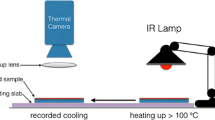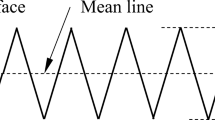Abstract
Nondestructive characterization of surface and subsurface properties is of increasing interest in industry and science. As destructive methods are inadequate for testing large devices (e.g. gear wheels for wind engines) or small series, nondestructive techniques for the assessment of their surface integrity are mandatory. Especially surface hardened components have to be examined in practice, as they tend to show varying properties regarding surface hardness, hardness penetration depth and residual stress profiles. Since the surface integrity has a major influence on the functional performance of components, assessment and monitoring of the surface properties is crucial. In this study, the results of a new technique for surface hardening (cold surface hardening) were investigated for the first time applying an emerging nondestructive measuring method: the photothermal near-surface layer characterization.










Similar content being viewed by others
References
Lonardo PM, Lucca DA, De Chiffre L (2002) Emerging trends in surface metrology. Ann CIRP 51(2):701–723
Lucca DA, Brinksmeier E, Goch G (1998) Progress in assessing surface and subsurface integrity. Ann CIRP 47(2):669–693
Field M, Kahles JF (1971) Review of surface integrity of machined components. Ann CIRP 20(2):153–163
Novovic D, Dewes RC, Aspinwall DK, Voice W, Bowen P (2004) The effect of machined topography and integrity on fatigue life. Int J Mach Tools Manuf 44(2–3):125–134
Brockhoff T, Brinksmeier E (1999) Grind-hardening: a comprehensive view. Ann CIRP 48(1):255–260
Kristoffersen H, Vomacka P (2001) Influence of process parameters for induction hardening on residual stresses. Mater Des 22(8):637–644
Karpuschewski B (1995) Mikromagnetische Randzonenanalyse geschliffener einsatzgehärteter Bauteile, Dr.-Ing. Dissertation, University of Hannover
Denkena B, Becker JC, Breidenstein B, Spille C (2004) Micromagnetic material characterization of thin steel sheet. Ann Ger Acad Soc Prod Eng (WGP) XI(2):43–46
Goch G, Walther HG, Thwaite EG (1998) Reconstruction of depth-dependent parameter profiles based on photothermal measurements. Ann CIRP 47(1):483–486
Goch G, Schmitz B, Geerkens J, Karpuschewski B, Reigl M, Sprongl P, Ritter R (1999) Review of non-destructive measuring methods for the assessment of surface integrity: a survey of new measuring methods for coatings, layered structures and processed surfaces. Precis Eng 23:9–33
Hirsch T, Wohlfahrt H, Macherauch E (1987) Fatigue strength of case hardened and shot peened gears. In: Wohlfahrt H, Kopp R, Vöhringer O (eds) Shot peening: science, technology, application. DGM Informationsgesellschaft, Oberursel, pp 547–560
Kobayashi M, Matsui T, Murakami Y (1998) Mechanism of creation of compressive residual stress by shot peening. Int J Fatigue 20(5):351–357
Schuhbauer H-G, Bäuerle H, Müller-Stock H-W (1991) Schwingfestigkeitssteigerung schwerer Maschinenbauteile durch Schlagverfestigen. Konferenz-Einzelbericht: Moderne Fertigungs-technologien zur Lebensdauersteigerung, 17. Vortragsveranstaltung des DVM-Arbeitskreises Betriebsfestigkeit, pp 53–64
Hacini L, Van Lê N, Bocher P (2008) Effect of impact energy on residual stresses induced by Hammer Peening of 304L plates. J Mater Process Technol 208(1–3):542–548
El-Axir MH (2000) An investigation into deep rolling. Int J Mach Tools Manuf 40:1603–1617
Röttger K (2003) Walzen hartgedrehter Oberflächen. Dissertation Dr.-Ing. RWTH Aachen, Shaker Verlag, Aachen
Brinksmeier E, Garbrecht M, Meyer D (2008) Cold surface hardening. Ann CIRP 57(1):541–544
Garbrecht M (2006) Mechanisches Randschichthärten in der Fertigung, Dr.-Ing. Dissertation, University of Bremen
Brinksmeier E, Garbrecht M, Meyer D, Dong J (2008) Surface hardening by strain induced martensitic transformation. Ann Ger Acad Soc Prod Eng (WGP) 2:109–116
Meyer D, Dong J, Garbrecht M, Hoffmann F, Brinksmeier E, Zoch H-W (2010) Mechanisch induziertes Härten. J Heat Treat Mater (HTM), accepted for publication in 2010
Goch G, Seidel U, Schmitz B, Reigl M, Walther HG, Lan TTN (1996) Photothermal hardness measurement for shafts. Bearings and Gears. Düsseldorf, VDI Verlag, pp 1031–1042
Reigl M (1997) Methoden zur Quantifizierung photothermischer Signale, Dr.-Ing. Dissertation, Ulm
Kruse D, Prekel H, Goch G (2008) Berührungslose Messung von Einhärtetiefen mittels photothermischer Randzonenanalyse. XXII. Messtechnisches Symposium des Arbeitskreises der Hochschullehrer für Messtechnik e.V. (AHMT). J. Czarske. Aachen, Shaker Verlag, pp 181–192
Goch G, Steiner R, Reick M, Schmitz B (1995) Photothermal detection of surface defects and thermal changes in near-surface layers. In: Balageas, Busse, Carlomagno (eds) Quantitative infrared thermography. Editions Europeenes Thermique et Industrie, Paris, pp 293–297
Kruse D, Prekel H, Goch G, Walther HG (2007) Correlation between hardening depth and thermal parameters based on photothermal measurements. Proc Estonian Acad Sci–Eng 13(4):423–435
Kruse D, Prekel H, Goch G (2006) Automated photothermal detection of burning and hardening depth. 9th International Conference on Infrared Sensors & Systems, Nürnberg, pp 341–346
Mandelis A (1994) Nondestructive evaluation, vol II. Progress in Photothermal and Photoacoustic Science and Technology, PTR Prentice Hall
Goch G, Prekel H, Patzelt S, Ströbel G, Lucca DA, Stock HR, Mehner A (2004) Nondestructive and contactless determination of layer thickness and thermal properties of PVD and sol-gel layers by photothermal methods. Ann CIRP 53(1):471–474
Kruse D, Prekel H, Goch G (2006) Photothermische Randzonenuntersuchung an wärmebehandelten Stählen und Objekten mit thermischer Schädigung. 13. ITG-/GMA-Fachtagung. Freiburg, Berlin, VDE Verlag, pp 173–177
Hertz H (1881) Über die Berührung fester elastischer Körper. J für die reine und angewandte Mathematik 92:156–171
Acknowledgments
Parts of this work were performed within the framework of the Collaboration Research Center (SFB) 570 “Distortion Engineering”, funded by the German Research Foundation. The authors furthermore thank for the projects’ funding by the Federal Ministry of Education and Research (BMBF) and the assistance of the working committee ‘‘Werkstoffe’’ of the Forschungsvereinigung Antriebstechnik e.V. (FVA).
Author information
Authors and Affiliations
Corresponding author
Rights and permissions
About this article
Cite this article
Meyer, D., Kruse, D., Bobe, A. et al. Nondestructive characterization of the surface integrity of cold surface hardened components. Prod. Eng. Res. Devel. 4, 443–449 (2010). https://doi.org/10.1007/s11740-010-0228-3
Received:
Accepted:
Published:
Issue Date:
DOI: https://doi.org/10.1007/s11740-010-0228-3




